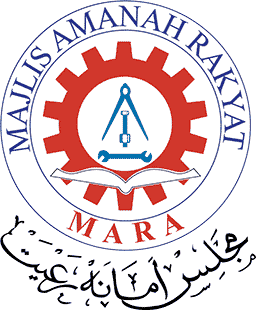Majlis Amanah Rakyat
| MARA | |
 | |
| Agency overview | |
|---|---|
| Formed | 1 March 1966 |
| Jurisdiction | Malaysia |
| Headquarters | Kuala Lumpur, Malaysia |
| Website | www |
The Majlis Amanah Rakyat (Malay: Council of Trust for the People, commonly abbreviated as MARA), is a Malaysian government agency. It was formed to aid, train, and guide Bumiputra (Malays and other indigenous Malaysians) in the areas of business and industry. MARA was formed on 1 March 1966 under the Rural and National Development Ministry.[1]
History and organisation
MARA was formed by an act of Parliament in 1966. It had originally begun as the Rural Industrial Development Authority (HYDRA), which was established by the British colonial administration in 1951, a program to provide economic assistance and support to Malay farmers and rural inhabitants.[2][3] This organisation was expanded in scope and became the MARA in 1966. Although it is an autonomous government agency, it reports to the Minister of Entrepreneurial and Cooperative Development, who appoints all the members of the MARA Council. Besides state-level offices in the 13 states of Malaysia and the Federal Territory of Kuala Lumpur, MARA operates three offices overseas — one in London, Washington, D.C. and another in Alexandria, Egypt.[4]
Entrepreneurship aid
Among other things, MARA offers loans to Bumiputra entrepreneurs.[5] Such loans may be repaid either in the conventional Western manner or in the style of Islamic banking, depending on the borrower's preference.[6] MARA also offers entrepreneurship courses, vocational training, consultancy services, and assistance in marketing for Bumiputra entrepreneurs.[7]
MARA constructs infrastructure, such as shoplots or factories, which are rented to Bumiputra entrepreneurs at a subsidised rate. These facilities are often constructed in towns or underdeveloped areas, to encourage further development there.[8]
Education

MARA also operates several junior colleges or boarding schools, and Universiti Kuala Lumpur. Previously, Universiti Teknologi MARA was operated by MARA; it has become its own entity under the Ministry of Higher Education. The junior colleges, referred to as Maktab Rendah Sains MARA (MARA Junior Science Colleges, often abbreviated as MRSMs), are operated by the Education & Training (Secondary) Department of MARA, whose stated mission is to "produce Bumiputra students of potential in science and technology".[9]
Until recently, the MRSMs were only open to Bumiputra students. However, the Barisan Nasional government pledged during its campaign for the 2004 general election that the MRSMs would be opened to all. Eventually, they were opened, with a quota allocating 10% of all places in MRSMs to non-Bumiputras.[10] In admissions, preference is given to students from low-income families, rural areas and/or those living in squatter settlements in the cities.[11]
In addition to MRSMs and the UniKL, vocational and professional colleges are operated by MARA such as Pusat GIAT MARA and Kolej Kemahiran MARA. These vocational colleges give a second lane of higher education to students who not be able to continue their studies in universities. There are also Kolej Kemahiran Tinggi MARA, German-Malaysian Institute, Kolej MARA and Kolej Professional MARA.[12]
Scholarships are offered to Bumiputra students for local and foreign institutions of higher learning. However, students must specialise in certain professions, such as engineering, medicine or accounting.[13]
Notes and references
- ^ Abdullah, Mustaza & Hj. Yahya, MatMarjani (1991). Kemahiran Hidup Bersepadu TERAS, p 108. Dewan Bahasa dan Pustaka. ISBN 983-62-2316-9.
- ^ Adam, Ramlah binti, Samuri, Abdul Hakim bin & Fadzil, Muslimin bin (2004). Sejarah Tingkatan 3, p. 134. Dewan Bahasa dan Pustaka. ISBN 983-62-8285-8.
- ^ "IMBASAN KEMBALI........". Retrieved 16 February 2006.
- ^ "MAKLUMAT KORPORAT". Retrieved 16 February 2006.
- ^ Abdullah & Hj. Yahya, p. 106.
- ^ "Jenis Pinjaman MARA". Retrieved 16 February 2006.
- ^ "Bahagian Pembangunan Usahawan - BPU". Retrieved 16 February 2006.
- ^ "BAHAGIAN PEMBANGUNAN INFRASTRUKTUR PERNIAGAAN(BPI)". Retrieved 16 February 2006.
- ^ "Profile". Retrieved 16 February 2006.
- ^ Pua, Tony (2005). "Mara Junior Science Colleges: A Peek". Retrieved 16 February 2006.
- ^ "PERATURAN KEMASUKAN KE MRSM". Retrieved 16 February 2006.
- ^ "PUSAT-PUSAT MARA". Retrieved 16 February 2006.
- ^ "Bahagian Penganjuran Pelajaran MARA - BPP". Retrieved 16 February 2006.
See also
- Te Puni Kōkiri an analogous body in New Zealand
- Mara Junior Science College Kuching, Sarawak
